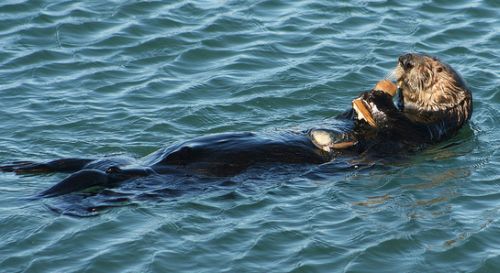
|
|
 Moss Landing, eating a Gaper Clam Sea Otter - Enhydra lutrisOverviewAn icon of the California coast, the Sea Otter is an aquatic member of the weasel family, found along the coasts of the Pacific Ocean in North America and Asia. The average adult can be as large as 1.5 m (about 5 feet) long and weigh up to 45 kg (about 90 pounds). Primarily, the Sea Otter's form of insulation is a thick coat of fur, up to 150,000 strands of hair per square centimeter making it the densest in the animal kingdom. Sea Otters depend on these hairs to keep them warm in the cold pacific water. If foreign substances such as oil soak into the fur, the Otter will not be able to remain waterproof and insulated. Therefore, Otters spend much of their time cleaning and grooming their fur with their teeth and paws. The Sea Otter inhabits offshore environments in which it forages on marine invertebrates such as sea urchins, mollusks, crustaceans, and some species of fish. In order to capture food, they must dive up to 250 feet to collect benthic invertebrates. They are often spotted cracking shellfish against a rock or other hard tool placed on their chest. These animals are social creatures that may float in groups of around 10 to 100; the groups are separated into sections of females and pups and another of males. In these groups they swim on their backs or eat while floating. Commonly, Sea Otters wrap themselves in kelp beds before resting or sleeping. Social groups on the ocean surface are important part of their lives, allowing them to eat, groom, rest, and interact. Their usual predators are Humans, Sharks, Bears, Eagles, and Killer Whales. Status and ConservationHistorically, humans have placed great value on these coats and hunted Otters nearly to extinction in the early 20th century until only 1,000 to 2,000 remained. Today, 100,000 to 150,000 Sea Otters are protected by the Endangered Species Act since 1977. Modern efforts to improve the status of Sea Otters began in the early 1920s because of the species' near extinction due to excessive hunting. Their territory once spanned from Japan to Alaska to Mexico across the North Pacific Ocean. According to the IUCN, significant threats to these creatures are oil pollution, predation by Orcas, poaching, and conflicts with fisheries. A small population of otters survived off the Big Sur coast in the early 20th century. Since then, they have expanded their range and have grown to almost 2,800. A survey in 2012 revealed the population has been able to spread from the south of Half Moon Bay to the south of Point Conception. Conservation efforts in Monterey have made an impact on the recovery and expansion. The Monterey Bay Aquarium's Sea Otter Program has been making efforts to save the threatened Southern Sea Otter since 1984. Otters are rescued, treated, and released. However, despite decades of dedication through federal and state protection, the otters are struggling to survive. Recent survey s count just 16,000 to 20,000 individuals, a fraction of their historic numbers. A major oil spill off the coast of California could pose a major threat to the population. Researchers are working to gain a better understanding of why the population's growth has stalled and want to find ways for this important species to recover. Where to ViewTheir normal range, in our area is from Big Sur to Half Moon Bay. They have very rarely been spotted in Tomales Bay and Richardson Bay.The Locations page has details about the places mentioned below.
Articles and Links
Video
|